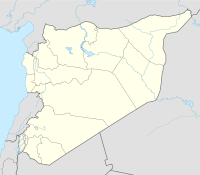Roman Theatre at Apamea
| المسرح الروماني بأفاميا | |
| Location | Apamea, Syria |
|---|---|
| Coordinates | 35°25′01″N 36°23′41″E / 35.416846°N 36.394821°E |
| Type | Roman theatre |
| Width | 145 metres (476 ft) |
| History | |
| Material | ashlar stones |
| Periods | Hellenistic, Roman, Byzantine |
| Site notes | |
| Excavation dates | 1931–1939 Late 1960s–1971 2007–2010 |
| Condition | partly ruined |
| Ownership | Public |
| Public access | Yes |
The Roman Theatre at Apamea (Arabic: المسرح الروماني بأفاميا) is a Roman theatre in ancient Apamea in northwestern Syria. Originally a Hellenistic theatre, the monumental structure was one of the largest theatres in the Roman world.
The theatre, along with the Roman Theatre at Ephesus, is one of the largest surviving theatres of the Roman world with a cavea diameter of 139 metres (456 ft) and an estimated seating capacity in excess of 20,000. The only other known theatre that is considerably larger was the Theatre of Pompey in Rome, with a cavea diameter of approximately 156.8 metres (514 ft).
However, much of the theatre structure is in ruins due to architectural collapses and extensive quarrying in later epochs, and only one-eighth of the site has been exposed so far. Situated along the western end of the decumanus, the monumental theatre was built into a steep hill overlooking the Orontes River valley. The north facing stage facade stretched for 145 metres (476 ft). The theatre's ima cavea was organized in 10 cunei, and had seats 0.41 metres (1.3 ft) high and 0.81 metres (2.7 ft) deep.
One of the main features at the theatre is its water basin and the elaborate Roman piping system used in it. The recently excavated terracotta system is located along the eastern ground entrance and is well preserved.
The theatre was originally a Hellenistic theatre dating to the early Seleucid era. The Hellenistic theatre probably lies under the Roman structures of the ima cavea, media cavea, and the orchestra. The theatre was expanded and remodeled in the early Roman period, during the reign of either Julius Caesar, Augustus, or Tiberius. The theatre's main stage was remodeled and its entrances were reorganized in a more typical Roman fashion. The 115 Antioch earthquake caused severe damage to the structure. It was rebuilt soon-after under patronage from both Trajan and Hadrian. The theatre was further expanded in the first half of the third century CE.
...
Wikipedia

